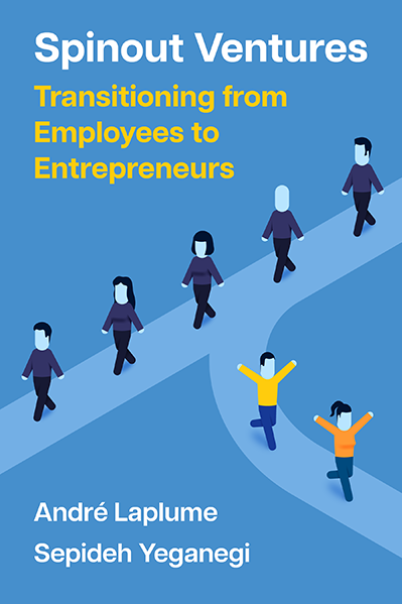Born open startup
What is a Born Open Startup?
A startup that is born open is one that rejects the notion of proprietary knowledge appropriation (e.g,. obtaining patents). In fact, software patents are probably the born open crowd's worst abomination.
A startup that is born open is one that rejects the notion of proprietary knowledge appropriation (e.g,. obtaining patents). In fact, software patents are probably the born open crowd's worst abomination.
Instead, a born open startup views itself as a part of a ecosystem of firms that work cooperatively and competitively. They typically are autonomous but have some interconnected goals. Open source startups participate in the development of a community of
firms with a shared governing policy to prevent the appropriation of the
technology.
If the technology is viewed as a hub that connects a network of stakeholders to each other to form a new value network that nurtures the technology and makes it more valuable for all the players, then it creates a self-reinforcing virtuous circle.
West and Gallagher (2006) suggest four strategies that organizations can employ to as part of their open source strategy. The first is benefiting from the economics of pooled product development and research and development. Another is spinouts that are beneficial to the parent firm but are self-sufficient and do not require as must investment from parents. Also, selling complements and attracting complements donated from others as another key benefit accelerating the development of the technology for the whole community.
When factions in an open source community disagree about the future direction of the technology, they may create a fork where a project develops a separate work stream from the main trunk and its proponents go their own way.
In order for a fork to keep enough momentum, it must have a community develop around it (e.g., Java). Alternatively, a fork can be used to develop a proprietary commercial product (e.g., Red Hat Linux) which neither infringes nor excludes other forks or streams. From an evolutionary perspective, each fork is variant of the original that develops new genes and new hosts!
Open source makes code immortal? I think one of the most interesting issues is that of looking at what constitutes a minimum level of attention for an innovation to be "sustained". There would also seem to be a minimum number of investors, entrepreneurs or managers willing to keep providing resources of their own into the technology; to keep a foothold in it just in case it blows up.
Sources:
MacAulay, M. (2010). GROWING REVENUE WITH OPEN SOURCE. The Open Source Business Resource, , 13-17.
Other theories or topics that might interest you:
Born global startups
Hybrid entrepreneurship
Disruptive innovation theory
Lean Launchpad theory
According to Mekki MacAulay,
"Open strategy involves the collective production of a shared good in an open fashion such that the resulting product is available to all, including competitors. In the case of open entrepreneurship, 'born-open' startups are entrepreneurial ventures whose business models are designed specifically based around a collective good. Such business models can be effective in industries with large, entrenched incumbents, particularly in areas related to software and online services."
If the technology is viewed as a hub that connects a network of stakeholders to each other to form a new value network that nurtures the technology and makes it more valuable for all the players, then it creates a self-reinforcing virtuous circle.
Knowing you will not hide assets forces strategic changes
Open source flips the conventional ownership intellectual property paradigm on its head. It starts with a philosophy that shared effort and resources toward developing a technology that can be used by many is more efficient (because the cost of development is shared) and effective (because better combinations can be made from shared resources) than closed systems.West and Gallagher (2006) suggest four strategies that organizations can employ to as part of their open source strategy. The first is benefiting from the economics of pooled product development and research and development. Another is spinouts that are beneficial to the parent firm but are self-sufficient and do not require as must investment from parents. Also, selling complements and attracting complements donated from others as another key benefit accelerating the development of the technology for the whole community.
When factions in an open source community disagree about the future direction of the technology, they may create a fork where a project develops a separate work stream from the main trunk and its proponents go their own way.
In order for a fork to keep enough momentum, it must have a community develop around it (e.g., Java). Alternatively, a fork can be used to develop a proprietary commercial product (e.g., Red Hat Linux) which neither infringes nor excludes other forks or streams. From an evolutionary perspective, each fork is variant of the original that develops new genes and new hosts!
Open source technologies need fans!
The the natural competitive forces of an economy shelves and destroys innovations whenever firms hoard them or let them fade away. Open source as a philosophy would have the project's artifacts (code) to be preserved for the collective and built upon more easily in the future.Open source makes code immortal? I think one of the most interesting issues is that of looking at what constitutes a minimum level of attention for an innovation to be "sustained". There would also seem to be a minimum number of investors, entrepreneurs or managers willing to keep providing resources of their own into the technology; to keep a foothold in it just in case it blows up.
Sources:
MacAulay, M. (2010). GROWING REVENUE WITH OPEN SOURCE. The Open Source Business Resource, , 13-17.
Other theories or topics that might interest you:
Born global startups
Hybrid entrepreneurship
Disruptive innovation theory
Lean Launchpad theory
